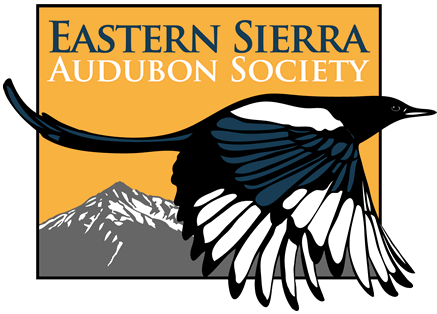Most birders enjoy woodpeckers. In fact, many can relate a favorite birding experience that involves a woodpecker. In a conversation with Roger Tory Peterson, a decade before his death he recounted to us that the first species that really got him hooked on birds was the Yellow-shafted (now Northern) Flicker. He said that it was still one of his favorite birds.
Woodpeckers are usually easy to watch due to their habits. They are not small or obscurely colored birds. They are not hyperactive, in view for a second and gone the next. In addition, they are not secretive, perching in plain view often for many minutes allowing a leisurely observation.
An even dozen species have been reliably documented for Inyo County and three-fourths of these are resident birds and relatively easy to find. The LEWIS´S WOODPECKER is an erratic visitor in the county. It is primarily a spring and fall migrant although it has nested rarely. Some years they winter at Furnace Creek Ranch and this past winter 15 were regularly reported. In 1973, two hundred spent the winter there feeding on dates.
The ACORN WOODPECKER is a casual visitor, that is, it is not reported every year. Most records are from the oak belt in the Sierra foothills at or south of Oak Creek Canyon. However, there are a handful of records scattered over the county. The most reliable site, when they are in town, is at the Mt. Whitney Fish Hatchery.
WILLIAMSON´S SAPSUCKER, an uncommon resident, breeds high in the Sierra and has recently been documented as a Breeder in the Inyo Mountains. There are also summer records for the White Mountains but there is no proof of breeding. In fall, many depart and move to lower elevations for the winter where the sap will continue to flow. They have been reported on the Death Valley Christmas Count a few times.
THE YELLOW-BELLIED SAPSUCKER is an eastern and northern species represented in Inyo County by two dozen records. One was a late January record from Furnace Creek Ranch; the rest were in October and November. Almost all sightings are of juveniles and great care must be taken to eliminate the more expected and very similar looking female Williamson´s and Red-naped sapsuckers. Any report requires solid documentation to verify it as a record.
The RED-NAPED SAPSUCKER is most often recorded in small numbers almost any day during fall migration. In winter, it is an uncommon visitor in the towns and riparian lowlands. There are but a few Breeding records at Whitney Portal and in the White- Mountains.
The RED-PEASTED SAPSUCKER is a fairly common summer breeding bird in the riparian canyons of the Sierra. During the rest of the year, it is uncommon in Owens Valley towns and along the Owens River. Interestingly the 1891 Death Valley Expedition did not record it even though they conducted many surveys of the east slope of the Sierra.
The LADDER-BACKED WOODPECKER is an uncommon species most often found in the south and east part of the county. Their preference for Joshua tree and desert riparian limits their distribution. They have nested north to Olancha and 27 miles east of Big Pine at Joshua Flat. Rarely is the species found along the Owens River. Great care must be taken to separate it from the very similar Nuttall´s Woodpecker. Hybrids have been found exhibiting characters of both species. The most reliable location in the county to see this bird is China Ranch, southeast of Tecopa.
NUTTALL´S WOODPECKER is a fairly common breeder in riparian habitat of the Owens Valley and the lower canyons of the Sierra. It is also found in towns throughout the valley. It was not discovered here until 1933 even though experienced ornithologists had conducted fieldwork. After nesting, a few wander to higher elevations in the Sierra.
The DOWNY WOODPECKER, smallest of all, is uncommonly found in the same locations and habitat as the Nuttall´s. There are just a few reports to the east of the Owens Valley.
The HAIRY WOODPECKER is the larger look-alike to the diminutive Downy. This species is found fairly commonly countywide in coniferous forests of all mountain ranges. A few have been found nesting on the floor of the Owens Valley.
The WHITE-HEADED WOODPECKER is a very uncommon resident of the Sierra above 8000´. It is found in fir, lodgepole and Jeffrey pine forests and has nested at Whitney Portal. This is the best location to search for this elusive species.
The NORTHERN FLICKER is probably the most familiar woodpecker as it regularly inhabits towns and often comes to feeders. It feeds primarily on suet, sunflower seeds, and in summer especially, ants. Our race, the Red-shafted Flicker, Peeds countywide in the riparian of the Owens Valley to high in the mountains. The eastern Yellow-shafted Flicker is found every fall usually from the Death Valley region. A few weeks ago, we banded an intergrade. That is, a cross between a Red-shafted and a Yellow-shafted Flicker. This is called an intergrade, as it is the offspring of two races while a hybrid is the offspring of two species.
For the most part woodpecker identification is straightforward and given good views, the observer will generally have few problems with this group. The danger zone is within the sapsucker group and separating Nuttall´s from Ladder-backed and Downy from Hairy. A little homework and a little luck will Ping you all the woodpeckers of Inyo County.
Tags: owl
